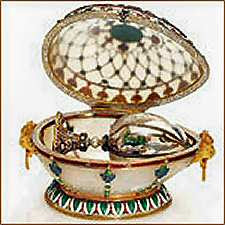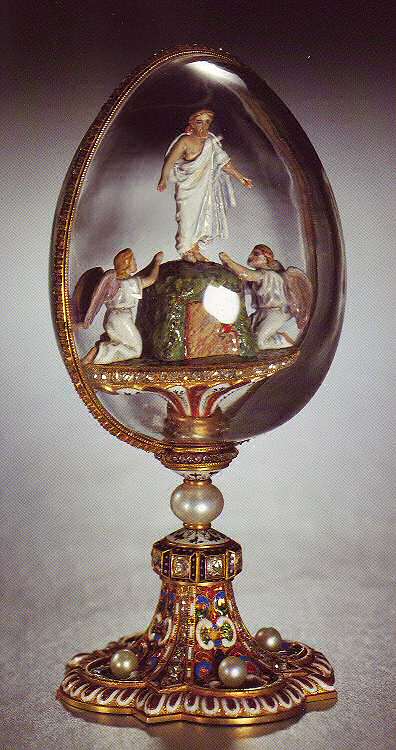Our introduction to the April 16, 2017 post:
The provenance on this egg is that it was not one of the eggs given by the Tsar to his wife Maria, the Empress consort, soon to be widow, of Alexander III, and mother of Nicholas II, the last Romanov Tsar.
Who presented it to Maria is an open question.
Additionally, Christopher Forbes, whose father had collected nine of the Fabergé Imperial Easter Eggs has proposed a theory that this egg is actually the surprise for the 1894 Renaissance Egg:

And from Mieks:
ca.
1885 - 1889 Resurrection Egg
Gift: unknown
Made in Saint Petersburg
Owner: The Link of Times-Collection Russia
Height: 9,8 cm
Made in Saint Petersburg
Owner: The Link of Times-Collection Russia
Height: 9,8 cm

The Resurrection Egg, also known as Transformation Egg, is made of yellow gold, rock crystal, rose-cut diamonds, pearls, brilliant diamonds, red, green, white, blue and black enamel.The Fabergé Research site does not give the Resurrection Egg a separate entry, instead giving it space in the Renaissance Egg (1894) spot but does have this comment in the section for the Winter Egg (1913):
In the form of a monstrance, the Resurrection Egg is one of Fabergé's masterpieces; exquisitely made in the manner of the Italian Renaissance, it is essentially a jewel.
The figure of Christ depicted standing above the tomb which is flanked by two kneeling angels, each figure naturalistically enameled, the robes enameled white, raised on an oval base bordered by diamonds, the underside with radiating flutes alternately enameled white and translucent strawberry red. The whole contained within a rock crystal egg-form shell with a vertical diamond-set band raised on a domed quatrefoil foot enameled with multicolored scrolls in Renaissance style and with diamond-set ribbons and mounted with four pearls. The pearl stem with a border of diamonds is marked with the Cyrillic initials of Fabergé and assay mark of 56 standard for 14 karat gold.
Background informationThe Resurrection Egg bears the early hallmark of head workmaster Michael Perkhin and the assay marks of St. Petersburg before 1899, a combination of marks dating it to between 1884 and about 1894. The Egg is not inscribed with a Fabergé inventory number....MORE

(Fabergé, Proler, and Skurlov, The Fabergé Imperial Easter Eggs, 1997, 210)
Background Notes: This is another Tsar Imperial egg that disappeared from public view for some decades, and happily reemerged in early 1993, when it was found in a shoebox under a bed in London’s Belgravia. It reputedly had sat on a bedroom table in the same apartment in 1979, left undisturbed when the flat was burgled.
If the House of Fabergé was often derivative, occasionally it could be brilliantly original. So it was with the Winter Egg, without doubt one of the most creative and technically challenging of all the Easter eggs Fabergé made for the tsar. It symbolizes the transition from winter to spring, the seed emerging into new life, the Resurrection. The spring flowers appear as if through a frosty mist inside the winter ice of the egg, before the egg is opened to reveal the surprise. Only in the First Tsar Imperial Egg, the Hen Egg of 1885, the 1885-89 Imperial Resurrection Egg, and the 1915 Tsar Imperial Red Cross Egg Triptych Egg is the Easter message so clearly illustrated. But none of these has the degree of delicacy achieved in the Winter Egg....